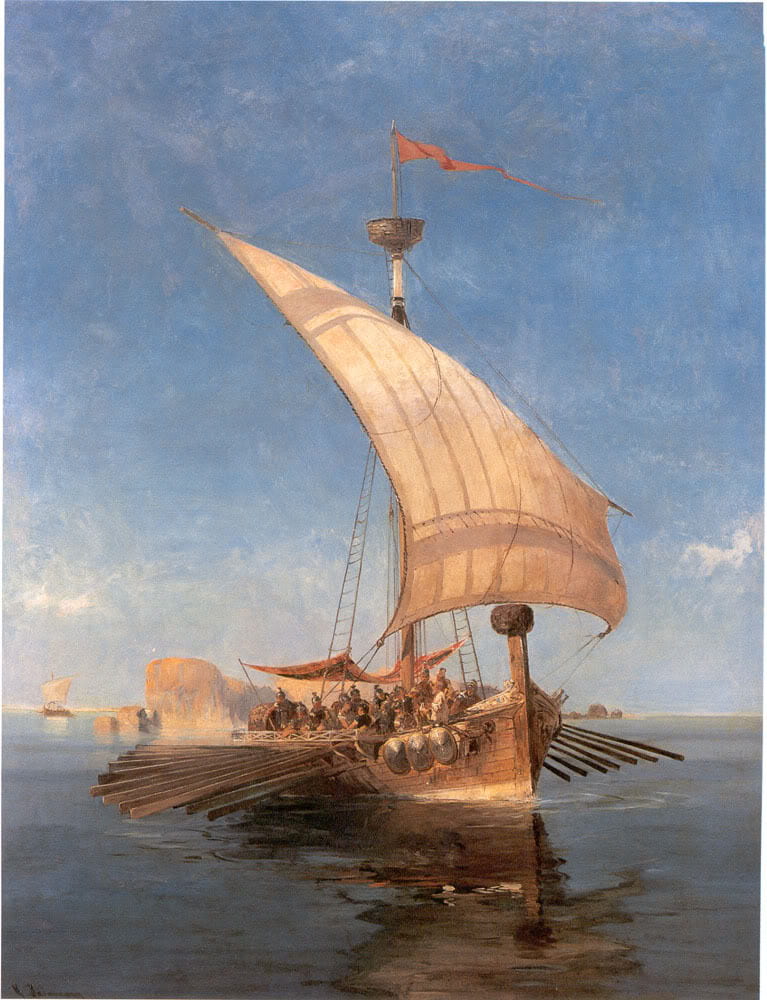Ancient Greece (Egypt)
Date of composition: 3rd century BCE
Apollonius of Rhodes,
Argonautica
Apollonius of Rhodes composed the Argonautica in the mid-third century BC, probably working for the most part in Alexandria, which as the capital of Egypt under the rule of the Ptolemaic dynasty had become an important centre of intellectual activity. He begins his poem by declaring that he will ‘recall the famous deeds of ancient men’; his subject will be the Argonauts, ‘who through the mouth of the Black Sea and the Blue Rocks … drove the well-benched Argo towards the golden fleece’ (Argonautica 1.1–4). The subject suggests a there-and-back-again adventure, while the terse parsing of the quest into beginning, middle, and end seems to promise a lucidly unfolding, neatly proportioned narrative.
The declarative simplicity of the opening is belied by the poem that follows. In length (nearly six thousand lines), language (an ornate poetic diction drawn primarily from Homer, remote from everyday speech, sparkling with rare words used unusually), and metre (dactylic hexameter), the Argonautica sits squarely in the epic tradition, and much of its subject matter is modelled on the Homeric poems, especially the Odyssey. But the poem’s conventional epic devices often deliver unfamiliar cargoes. The Argonauts retrace the steps of Odysseus and his men, but without making the same mistakes (they give the Cattle of the Sun a wide berth, 4.964–81) or suffering the same traumas (obliging nymphs, at Hera’s behest, steer them unharmed past Scylla, Charybdis, and the Wandering Rocks, 4.920–63). When the Argonauts do battle accidentally with the inhabitants of Cyzicus (1.1012–77), when Hera and Aphrodite conspire to help Jason against Aeetes, king of Colchis and owner of the golden fleece (3.6–110), and when Jason slays the ‘Sown Men’ who spring from the earth he has just ploughed with Aeetes’ fire-breathing bulls (3.1354–1407), readers are meant to recognise Homeric language and story patterns reimagined to create freshly pathetic, amusing, and unsettling effects.
In structure and theme, the Argonautica thrives as much on its departures from Homer as on imitative refashioning. Jason is not a heroic warrior in the Homeric mould. He owes his success in capturing the golden fleece to Medea’s sorcery, and he is often seized by a mood of ‘helplessness’ when contemplating his tasks. Whereas Odysseus is famed for his trickery and Achilles his fiery temperament, Jason’s political virtues are more muted. Conciliation and compromise mark a relationship with his fellow Argonauts which is more that of a primus inter pares than that of the superior warrior standing out from his people (the paradigm famously elaborated by Sarpedon at Iliad 12.310–28). Learned ethnographic digressions and accounts of strange natural phenomena, redolent of Herodotus and other prose writers, punctuate the narrative.
Similarly innovative is the poem’s preoccupation with the psychology of desire. Through soliloquies and a remarkable interior monologue, the poem traces the intricate workings of Medea’s mind as she is tormented by contrary impulses, the longing to fulfil her desire for Jason and the demands of dutiful comportment towards her family. Attention is often drawn to her volatile emotions throughout the poem’s final book, and the appalling outcome of Medea and Jason’s marriage, well known to Apollonius and his readers from Euripides’ play Medea and alluded to by similes that compare Medea to a woman bereft of her husband (3.656–64, 4.1061–7), persistently overshadows the action. By alluding to a literary model that describes events occurring after those that his own poem records, Apollonius achieves effects different from those created by the strategies of anticipation that Homer employs.
How valuable a poem is the Argonautica? The author of the celebrated treatise On the Sublime (usually dated to the first century AD) contrasted Apollonius’ ‘flawless’ poetic surface with Homer’s greater power and profundity, while P. B. Shelley grouped Apollonius among the ‘mock-birds’, whom he judged deft imitators of Homer rather than original poets. Similar verdicts largely held sway until the 1980s, when critics began to redeem the poem by reading it as a virtuoso display of scholarly learning and a creative interrogation of the genre’s resources. That Apollonius strongly influenced Virgil’s depiction of Dido and handling of the relationship between political circumstances and personal experience in the Aeneid is now a scholarly commonplace. More recent scholarship has interpreted the Argonautica as a skillful contribution to its socio-political environment, seeing its treatment of kingship and community as a response to the political dispensations that had emerged in the Hellenistic kingdoms or as an attempt to provide mythopoetic legitimacy for Ptolemaic rule. Other readers have responded very differently, finding in the poem’s vacillating characters and chronicles of emotional disturbance evidence of an ironic or even cynical worldview which sees human beings as prey to forces against which flimsy social and intellectual conventions offer, at best, fragile defence. Even readers drawn by the overarching narrative to see the poem as primarily a celebration of heroic achievement have to reckon with the disturbing ambiguities of its characters and events.
Such effects are to the fore when Apollonius describes the last danger that the Argonauts face, the bronze giant Talos, whom Zeus has left as a ‘guard’ on the island of Crete. When Talos prevents the ship from putting in to shore, Medea bewitches him. Talos strikes his ankle, the one vulnerable part of his body, on a rock, his life force ebbs from the wound, and he falls down dead (4.1638–88). When Medea is led by Jason onto the higher deck, their clasped hands and the gesture with which she ‘drew a fold of her robe over both cheeks’ (4.1661–2), suggest a marriage ritual. But Medea is no sooner figured as a bride-to-be than she acts with a ‘rage’ redolent of a warrior in battle (4.1672). Scientific and ritual discourse blend uneasily in the account of the bewitchment: the ‘heart-destroying Fates’ that Medea calls into action belong to the everyday world of spells and curses, but the ‘destructive phantoms’ which her hate-filled gaze projects at her adversary are described in terminology borrowed from philosophical theories of vision (4.1671–2). Comparing Talos to a tree in the mountains that falls after being chopped by ‘woodcutters’ with ‘swift axes’, Apollonius employs language that evokes a Homeric warrior falling in battle and invites us to pity Talos’ vulnerability. But also legible here is a contrast between the blows of the axes and the invisible but no less wounding insinuation of Medea’s ‘phantoms’; the ease with which we imagine the former alerts us to the latter’s disconcerting elusiveness. The melange of registers, cultural associations, and literary models at work in this episode typifies a poem that at every turn unbalances readers’ expectations.
Tom Phillips
University of Manchester
Resources
Editions:
H. Fränkel, Apollonii Rhodii Argonautica (Oxford, 1961).
R. Hunter, Apollonius of Rhodes: Jason and the Golden Fleece (Oxford, 1993).
W. H. Race, Apollonius Rhodius Argonautica (Cambridge Mass., 2008).
Critical studies:
J. Clauss, The Best of the Argonauts (Berkeley, 1993).
R. Hunter, Apollonius Rhodius’ Argonautica: Literary Studies (Cambridge, 1993).
A. Mori, The Politics of Apollonius Rhodius’ Argonautica (Cambridge, 2008).
A. Morrison, Apollonius Rhodius, Herodotus and Historiography (Cambridge, 2020).
T. Phillips, Untimely Epic: Apollonius Rhodius’ Argonautica (Oxford, 2020).
S. Stephens, Seeing Double: Intercultural Poetics in Ptolemaic Alexandria (Berkeley, 2003).
The above bibliography was compiled by Tom Phillips (University of Manchester).
Lorenza Costa (c. 1460-1535), The Argonauts.
Biagio D’Antonio, Scenes from the Story of the Argonauts (c. 1465).
Pietro Francavilla, Jason (1589).
Jacopo del Sellaio, Scenes from the Story of the Argonauts (c. 1465):
A fourth century Sicilian krater showing the meeting of Jason and Medea.

